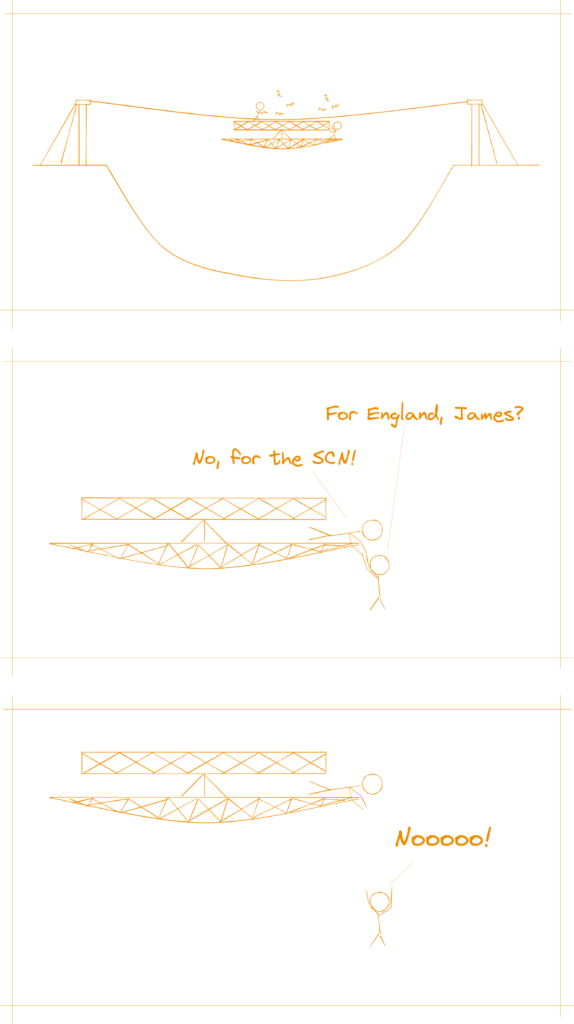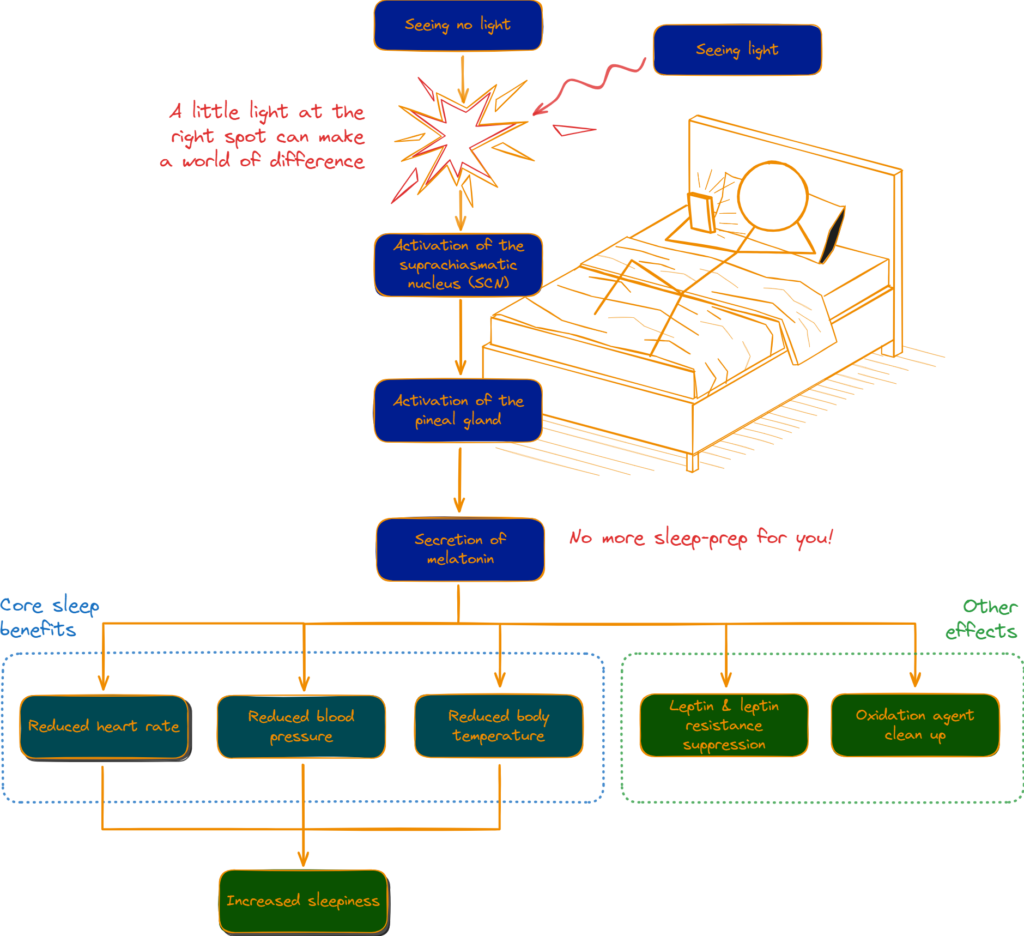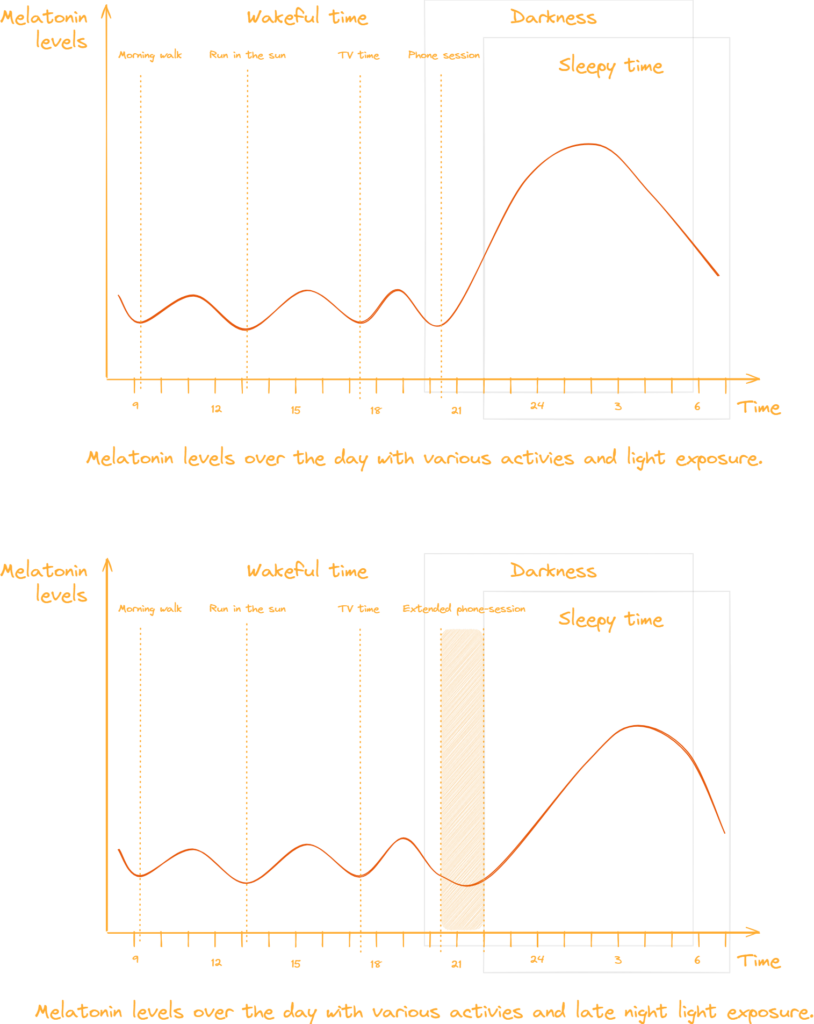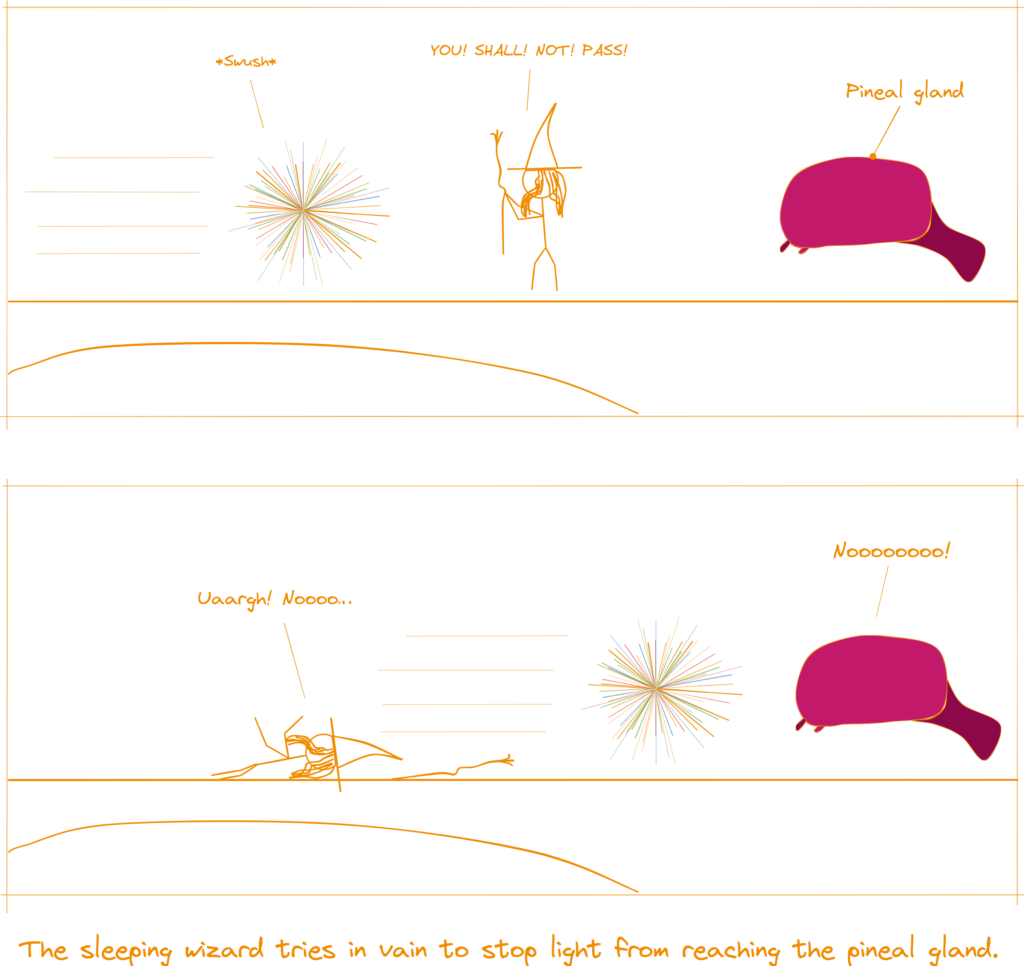Intro
Light is ultimate. It powers the major sensors, not just of humans but many mammals, with the tenacity of an “eternal” fusion reactor. Without it life on earth would likely be little more than the glimmer of a dream in the infinity of space [Rapf 2016].
But light isn’t only sparkles and rainbows; it also has a dark side to itself. One that cripples the very mechanisms of sleep the common human so relies on.
It isn’t light’s fault. In fact, the sleep deprivation it causes and a lot of humans suffer from is in many instances self inflicted. The tool of choice is often a small innocent looking object, humans carry everywhere like a totem. If they lose it, they become distrought and scream at each other. Perhaps that’s why they even take it to bed and stare at it deep into the darkness of night
[Bonnet 1995, Elsheikh 2023, Hoyos 2015, Lloyd-Jones 2022, Ohayon 2017, Rogers 2024].
But the light emitting object demands a toll, a sacrifice from their human worshipers. It is their very state of mind it strains in multiple ways.
Social media, which is often the center of attention during these late “research and relax” sessions, and its effects on mental health will be the topic for another article [Braghieri 2022, Elsheikh 2023].
In this article we will take a look at the disrupting properties of light in general and the tiny screens of human adoration in particular. So buckle up, set your brightness to low and enjoy the nosy dive into the topic of…
Light-pollution and sleep
The biology of light-pollution
Shameless advertisement
Avid readers will surely remember our look at melatonin and its interaction with light and darkness. As a reminder: not at the slightest, but somewhat sight of darkness, the pineal gland releases melatonin to prepare the common human for sleep.
Therefore, under normal conditions melatonin ebbs through the day and peaks at night acting as an agent of humanity’s primary circadian clock [Hughes 2000, Zeitzer 1999].

A history of light pollution
And this truth held up for most of human history. The sun was typically down or about to be when humans went to sleep and the peak light sources that stick and stone technology offeredFIRE, FIRE, FIRE! emitted predominantly low energy light that doesn’t impact the melatonin release as much [Gooley 2011, Holtzmann 2010].
Not even the first light bulbs impacted humans that much as they also emitted relatively low levels of high energy light [Cornell 2001].
But humans in their quest for all things shiny invented too greedily and developed light-sources so powerful that the age old mechanisms of their thinking machines were no longer able to distinguish day from night.
Light pollution, one of the many nightmares of hard working astronomers, didn’t just become a bane of outside stargazing, but also bedroom sleepiness.
The mechamism of light pollution

And nowadays when humans blissfully lie in there bed, relaxing after a hard day with a light show (Ha, see what I did there?), some social media or a game or two, they don’t realize that they disrupt a chain of events that evolution set up for them over millions of years.
But why does the body react so old fashioned and way out of proportion to some little shiny particles…ehm…waves…ok particles and waves swushing through space?

As we pointed out here, the majority of the human body is blissfully unaware of the intentions of its consciousness. And therefore as long as the pineal gland gets the info that the human visual sensors are registering light, it will keep the melatonin-gates closed [Gooley 2011]. Especially if high energy light of the blue kind is on the visual plate [Brainard 2001].
Maybe they are outside and traveling accross continents. What do I know.
Pineal Gland

Methods against light-pollution
Put your phones away before you go to sleep
The best advice to give humans for a good nights rest is to reduce their light exposure before sleepy time. The less light the better. If there is no other way around it, the lights used should be of the low energy kind, as in red nature, with as little blue parts as possible.
Limit light exposute during sleep and when temporarily waking
Also during sleep, light exposure should be as little as possible. If not, the melatonin-levels plummet and sleep becomes as shallow as a self absorbed billionaire heir [Cho 2013], Mason 2022]. Ideally keep the lights off, if necessary ambient illumination to a minimum and / or wear a sleep mask.
The same applies to toilet runs in the middle of the night. Best is to keep the lights off or as low as possible.
Consider eye-color
Especially those individuals with lighter eye-colors (e.g. blue or green) should take extra care to limit light exposure. Their eye-pigmentation tends to make them more sensitive to light and its suppressive effect on melatonin-secretion [Higuchi 2007].
Blue light blocking glasses
Alternatively or in addition, the use of blue-blocking glasses during the last hours before bedtime has proven itself as a way to limit the detrimental effects of light exposure [Kimberly 2009, Sasseville 2006].
Outro
As a final night, keep in mind to care for the light and perhaps instead of checking the latest and flashiest of updates on whatever your glowing box of choice offers, consider yoga and another form of calm rest as a pre-sleep routine.
Mind the light.
Sources
| Key | Citation |
|---|---|
| Bonnet 1995 | Bonnet, M. H., & Arand, D. L. (1995). We are chronically sleep deprived. Sleep, 18(10), 908-911. |
| Braghieri 2022 | Braghieri, L., Levy, R. E., & Makarin, A. (2022). Social media and mental health. American Economic Review, 112(11), 3660-3693. |
| Brainard 2001 | Brainard, G. C., Hanifin, J. P., Greeson, J. M., Byrne, B., Glickman, G., Gerner, E., & Rollag, M. D. (2001). Action spectrum for melatonin regulation in humans: evidence for a novel circadian photoreceptor. Journal of Neuroscience, 21(16), 6405-6412. |
| Cho 2013 | Cho, J. R., Joo, E. Y., Koo, D. L., & Hong, S. B. (2013). Let there be no light: the effect of bedside light on sleep quality and background electroencephalographic rhythms. Sleep medicine, 14(12), 1422-1425. |
| Cornell 2001 | Cornell University Program of Computer Graphics. (2001). Light Source Spectra. https://www.graphics.cornell.edu/online/measurements/source-spectra/index.html |
| Elsheikh 2023 | Elsheikh, A. A., Elsharkawy, S. A., & Ahmed, D. S. (2023). Impact of smartphone use at bedtime on sleep quality and academic activities among medical students at Al-Azhar University at Cairo. Journal of Public Health, 1-10. |
| Gooley 2011 | Gooley, J. J., Chamberlain, K., Smith, K. A., Khalsa, S. B. S., Rajaratnam, S. M., Van Reen, E., … & Lockley, S. W. (2011). Exposure to room light before bedtime suppresses melatonin onset and shortens melatonin duration in humans. The Journal of Clinical Endocrinology & Metabolism, 96(3), E463-E472. |
| Higuchi 2007 | Higuchi, S., Motohashi, Y., Ishibashi, K., & Maeda, T. (2007). Influence of eye colors of Caucasians and Asians on suppression of melatonin secretion by light. American Journal of Physiology-Regulatory, Integrative and Comparative Physiology, 292(6), R2352-R2356. |
| Holtzmann 2010 | Holzman, D. C. (2010). What’s in a color? The unique human health effects of blue light. |
| Hoyos 2015 | Hoyos, C., Glozier, N., & Marshall, N. S. (2015). Recent evidence on worldwide trends on sleep duration. Current Sleep Medicine Reports, 1, 195-204. |
| Hughes 2000 | Howard Hughes Medical Institute. (2000). The Mammalian Biological Clock. https://www.biointeractive.org/classroom-resources/mammalian-biological-clock. |
| Kimberly 2009 | Kimberly, B., & James R, P. (2009). Amber lenses to block blue light and improve sleep: a randomized trial. Chronobiology international, 26(8), 1602-1612. |
| Lloyd-Jones 2022 | Lloyd-Jones, D. M., Allen, N. B., Anderson, C. A., Black, T., Brewer, L. C., Foraker, R. E., … & American Heart Association. (2022). Life’s essential 8: updating and enhancing the American Heart Association’s construct of cardiovascular health: a presidential advisory from the American Heart Association. Circulation, 146(5), e18-e43. |
| Mason 2022 | Mason, I. C., Grimaldi, D., Reid, K. J., Warlick, C. D., Malkani, R. G., Abbott, S. M., & Zee, P. C. (2022). Light exposure during sleep impairs cardiometabolic function. Proceedings of the National Academy of Sciences, 119(12), e2113290119. |
| Ohayon 2017 | Ohayon, M., Wickwire, E. M., Hirshkowitz, M., Albert, S. M., Avidan, A., Daly, F. J., … & Vitiello, M. V. (2017). National Sleep Foundation’s sleep quality recommendations: first report. Sleep health, 3(1), 6-19. |
| Rapf 2016 | Rapf, R. J., & Vaida, V. (2016). Sunlight as an energetic driver in the synthesis of molecules necessary for life. Physical Chemistry Chemical Physics, 18(30), 20067-20084. |
| Rogers 2024 | Rogers, E. M., Banks, N. F., & Jenkins, N. D. (2024). The effects of sleep disruption on metabolism, hunger, and satiety, and the influence of psychosocial stress and exercise: A narrative review. Diabetes/metabolism research and reviews, 40(2), e3667. |
| Sasseville 2006 | Sasseville, A., Paquet, N., Sévigny, J., & Hébert, M. (2006). Blue blocker glasses impede the capacity of bright light to suppress melatonin production. Journal of pineal research, 41(1), 73-78. |
| Zeitzer 1999 | Zeitzer, J. M. (1999). Physiology and anatomy of human circadian photoreception and melatonin regulation. Harvard University. |


Leave a Reply